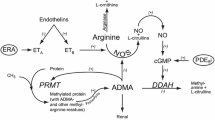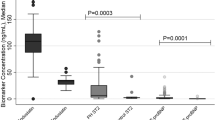Abstract
This study investigated the clinical value of plasma asymmetrical dimethyl-l-arginine (ADMA) level in the diagnosis, staging, and treatment response in congenital heart disease (CHD) patients with pulmonary arterial hypertension (PAH). This was a single-center prospective observational study in 80 CHD patients. Plasma ADMA levels were measured by enzyme-linked immunosorbent assay. Plasma ADMA levels were significantly increased in CHD patients with PAH compared with CHD patients without PAH (P < 0.01) and healthy controls (P < 0.001). In CHD patients with severe PAH, plasma ADMA levels were significantly higher in patients with Eisenmenger’s syndrome (ES) than in patients exhibiting low pulmonary vascular resistance (P < 0.001). The plasma ADMA levels significantly correlated with pulmonary arterial pressure (P < 0.001) and pulmonary vascular resistance (P < 0.001) in patients with CHD. Severe PAH was identified by plasma ADMA with a cutoff value of 0.485 μmol/L (P < 0.001) with a specificity of 82.8 % and a sensitivity of 90 %. ES was identified by plasma ADMA with a cutoff value of 0.85 μmol/L (P < 0.05) with a specificity of 85.2 % and a sensitivity of 64.3 %. ADMA levels were significantly decreased after sildenafil therapy for 6 months compared with before therapy levels (0.91 ± 0.22 vs. 0.57 ± 0.30, P < 0.01). Our study suggests that plasma ADMA level may be used as a biomarker for identifying PAH in patients with CHD, assessing pulmonary vascular remodeling, and evaluating the treatment response of CHD patients with PAH to sildenafil.


Similar content being viewed by others
References
Altuntaş M, Atalay F, Can M, Altın R, Tor M (2011) Serum asymmetric dimethylarginine, nitrate, vitamin B(12), and homocysteine levels in individuals with pulmonary embolism. Mediat Inflamm 2011:50–57
Beghetti M, Tissot C (2010) Pulmonary hypertension in congenital shunts. Rev Esp Cardiol Engl Ed 63:1179–1193
Chau EM, Fan KY, Chow WH (2007) Effects of chronic sildenafil in patients with Eisenmenger syndrome versus idiopathic pulmonary arterial hypertension. Int J Cardiol 120:301–305
Cooper CJ, Landzberg MJ, Anderson TJ, Charbonneau F, Creager MA, Ganz P, Selwyn AP (1996) Role of nitric oxide in the local regulation of pulmonary vascular resistance in humans. Circulation 93:266–271
D’Alto M, Mahadevan VS (2012) Pulmonary arterial hypertension associated with congenital heart disease. Eur Respir Rev 21:328–337
Dinh-Xuan AT, Higenbottam TW, Clelland CA, Pepke-Zaba J, Cremona G, Butt AY, Large SR, Wells FC, Wallwork J (1991) Impairment of endothelium-dependent pulmonary-artery relaxation in chronic obstructive lung disease. N Engl J Med 324:1539–1547
El-Shanshory M, Badraia I, Donia A, Abd El-Hameed F, Mabrouk M (2013) Asymmetric dimethylarginine levels in children with sickle cell disease and its correlation to tricuspid regurgitant jet velocity. Eur J Haematol 91:55–61
Foris V, Kovacs G, Tscherner M, Olschewski A, Olschewski H (2013) Biomarkers in pulmonary hypertension: what do we know? Chest 144:274–283
Galiè N, Hoeper MM, Humbert M, Torbicki A, Vachiery JL, Barbera JA, Beghetti M, Corris P, Gaine S, Gibbs JS et al (2009) Guidelines for the diagnosis and treatment of pulmonary hypertension: the Task Force for the Diagnosis and Treatment of Pulmonary Hypertension of the European Society of Cardiology (ESC) and the European Respiratory Society (ERS), endorsed by the International Society of Heart and Lung Transplantation (ISHLT). Eur Heart J 30:2493–2537
Gorenflo M, Zheng C, Werle E, Fiehn W, Ulmer HE (2001) Plasma levels of asymmetrical dimethyl-l-arginine in patients with congenital heart disease and pulmonary hypertension. J Cardiovasc Pharmacol 37:489–492
Kielstein JT, Bode-Böger SM, Hesse G, Martens-Lobenhoffer J, Takacs A, Fliser D, Hoeper MM (2005) Asymmetrical dimethylarginine in idiopathic pulmonary arterial hypertension. Arterioscler Thromb Vasc Biol 25:1414–1418
Krishnan U, Rosenzweig EB (2013) Pulmonary arterial hypertension associated with congenital heart disease. Clin Chest Med 34:707–717
Kyle WB (2012) Pulmonary hypertension associated with congenital heart disease: a practical review for the pediatric cardiologist. Congenit Heart Dis 7:575–583
Laaban JP, Diebold B, Zelinski R, Lafay M, Raffoul H, Rochemaure J (1989) Noninvasive estimation of systolic pulmonary artery pressure using Doppler echocardiography in patients with chronic obstructive pulmonary disease. Chest 96:1258–1262
LaFarge CG, Miettinen OS (1970) The estimation of oxygen consumption. Cardiovasc Res 4:23–30
Lopes A, Alnajashi K (2014) Saudi guidelines on the diagnosis and treatment of pulmonary hypertension: pulmonary arterial hypertension associated with congenital heart disease. Ann Thorac Med 9(Suppl 1):S21–s25
Millatt LJ, Whitley GS, Li D, Leiper JM, Siragy HM, Carey RM, Johns RA (2003) Evidence for dysregulation of dimethylarginine dimethylaminohydrolase I in chronic hypoxia-induced pulmonary hypertension. Circulation 108:1493–1498
Rabinovitch M, Haworth SG, Castaneda AR, Nadas AS, Reid LM (1978) Lung biopsy in congenital heart disease: a morphometric approach to pulmonary vascular disease. Circulation 58:1107–1122
Sanli C, Oguz D, Olgunturk R, Tunaoglu FS, Kula S, Pasaoglu H, Gulbahar O, Cevik A (2012) Elevated homocysteine and asymmetric dimethyl arginine levels in pulmonary hypertension associated with congenital heart disease. Pediatr Cardiol 33:1323–1331
Singh TP, Rohit M, Grover A, Malhotra S, Vijayvergiya R (2006) A randomized, placebocontrolled, double-blind, crossover study to evaluate the efficacy of oral sildenafil therapy in severe pulmonary artery hypertension. Am Heart J 151:851.e1–e5
Skoro-Sajer N, Mittermayer F, Panzenboeck A, Bonderman D, Sadushi R, Hitsch R, Jakowitsch J, Klepetko W, Kneussl MP, Wolzt M, Lang IM (2007) Asymmetric dimethylarginine is increased in chronic thromboembolic pulmonary hypertension. Am J Respir Crit Care Med 176:1154–1160
Vargo TA (1998) Cardiac catheterization: hemodynamic measurements. In: Garson A, Bricker JT, Fisher DJ, Neish SR (eds) The science and practice of pediatric cardiology, 2nd edn. Lippincott Williams & Wilkins, Baltimore, pp 961–993
Vongpatanasin W, Brickner ME, Hillis LD, Lange RA (1998) The Eisenmenger syndrome in adults. Ann Intern Med 128:745–755
Warwick G, Thomas PS, Yates DH (2008) Biomarkers in pulmonary hypertension. Eur Respir J 32:503–512
Acknowledgments
The authors would like to thank Drs. Jiang Li, Yi Tang, and Jiming Zhou for their assistances in the study.
Conflict of interest
All the authors have reported that they have no relationships relevant to the contents of this paper to disclose.
Author information
Authors and Affiliations
Corresponding author
Rights and permissions
About this article
Cite this article
Fang, Zf., Huang, Yy., Tang, L. et al. Asymmetric Dimethyl-l-Arginine is a Biomarker for Disease Stage and Follow-Up of Pulmonary Hypertension Associated with Congenital Heart Disease. Pediatr Cardiol 36, 1062–1069 (2015). https://doi.org/10.1007/s00246-015-1127-3
Received:
Accepted:
Published:
Issue Date:
DOI: https://doi.org/10.1007/s00246-015-1127-3




